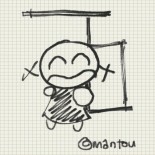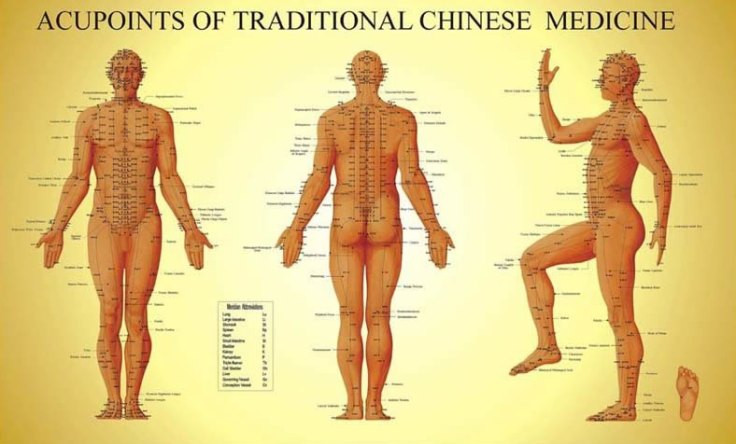So, a friend of my friend wanna find out more about this, “How does acupuncture work?”
Good question.
Ok, we do not just randomly poke on the patient’s body. The needles are placed on the specific meridian points of the body to achieve the specific healing effects.
Next, let’s talk meridians.
Meridians, like main water pipelines, are the key channels which qi moves within to respective vital organs and extremities. They form a network system within the body.
There are 12 main meridians respectively connecting to different vital organs, namely:
- Lung (肺) :
- 手太阴肺经 | Lung Meridian of Hand – Taiyin, LU
- Large Intestine (大肠) :
- 手阳明大肠经 | Large Intestine Meridian of Hand – Yangming, LI
- Stomach (胃) :
- 足阳明胃经 | Stomach Meridian of Foot – Yangming, ST
- Spleen (脾):
- 足太阴脾经 | Spleen Meridian of Foot – Taiyin, SP
- Heart (心):
- 手少阴心经 | Heart Meridian of Hand – Shaoyin, HT
- Small Intestine (小肠) :
- 手太阳小肠经 | Small Intestine Meridian of Hand – Taiyang, SI
- Bladders (膀胱) :
- 足太阳膀胱经 | Bladder Meridian of Foot – Taiyang, BL
- Kidneys (肾) :
- 足少阴肾经 | Kidney Meridian of Foot – Shaoyin, KI
- Pericardium (心包) :
- 手厥阴心包经 | Pericardium Meridian of Hand – Jueyin, PC
- Sanjiao (三焦) :
- 手少阳三焦经 | Sanjiao Meridian of Hand – Shaoyang, SJ
- Gallbadder (胆) :
- 足少阳胆经 | Gallbladder Meridian of Foot – Shaoyang, GB
- Liver (肝) :
- 足厥阴肝经 | Liver Meridian of Foot – Jueyin, LI
And these main meridians eventually form a closed loop within the body.
The 8 Special Ones
In addition, there are also 8 extra meridians which qi does not have the direct passage to nourish the organs. They have their own channel pathways, namely:
- Du (督) :
- 督脉 | Du Meridian, DU
- Ren (任) :
- 任脉 | Ren Meridian, RN
- Chong (冲) :
- 冲脉 | Chong Meridian
- Dai (带) :
- 带脉 | Dai Meridian
- Yinwei (阴维) :
- 阴维脉 | Yingwei Meridian
- Yangwei (阳维) :
- 阳维脉 | Yangwei Meridian
- Yinqiao (阴跻) :
- 阴跻脉 | Yinqiao Meridian
- Yanqiao (阳跻) :
- 阳跻脉 | Yangqiao Meridian
Besides DU & RN, there is no abbreviation for the other 6 extra meridians.
These 8 extra meridians are like energy boosters to the 12 main meridians. They travel alongside with the similar relating meridians and join at a certain junction (i.e. specific acupuncture point) to provide boosting nourishment to the respective organs.
These 12 main meridians, 2 of the extra meridians and spleen’s major network branch out to form 15 collaterals.
Within the meridian network system, there are more to these but I’m not going to dwell on the details.
Acupuncture Points
In each of these meridians, there are plenty of acupuncture points (similar to water tap point) along these respective meridian channels, at different and specific parts of the body.
Now for all these acupuncture points, they have:
- specific anatomical locations using methods like bone proportion Cun, anatomical landmark or by finger Cun
- specific healing effects and
- specific needling depths, angles.
Some of these also have unique healing effects.
There can also be points which do not have any landmarks along any meridian and these are just basically called Ashi points (阿是穴).
Many times, adopting the concept of the qi mechanism within meridian network system, the physician will use a combination of acupuncture points to enhance the effectiveness.
So therefore, there can be times when you show your physician of the area of complaints, the physician does not just acupuncture on the area itself, but he/she also acupunctures near or away from it.
What Kind of Needles Are We Using?

No, no, no…we are no longer using our own acupuncture needles and we no longer disinfect the needles under burning candles. And definitely we are not using those sewing needles, so pleaseeeee don’t use those to try poking on yourself!! The TCM physicians and acupuncturists are trained in schools and certified by Singapore TCM Practitioners Board to practise in Singapore.
The acupuncture needles are typically made of stainless steel and they are flexible. They are disposable and only for one-time use.


For those who have been to TCM clinics for acupuncture, you would have seen the different needle lengths. These lengths are to cater to different part of the body, as well as different thickness of the body muscles.
What Are We As Patients Expecting to Feel During And After Acupuncture?
Yup, to get you more mentally, emotionally prepared for any acupuncture session, let me take you on a mini orientation…
- Before proceeding to any acupuncture session, the physician will ask a series of questions about your complaints and your current physical condition (i.e. whether you are suitable for the day’s acupuncture).
- Just as the needle is poked through the top layer of skin, you may experience a temporary mosquito-bite or almost no sensation. It is also important that you should stay relax!!
- As the needle goes deeper into the acupuncture point and to achieve the effectiveness of the acupuncture treatment, you should be able to feel one, or a combination of such needling sensation: sore, heavy or numb. This is where the physician uses the needle on the acupuncture point to trigger the qi flow and thus the healing effect within the meridian.
- The needles will then stay intact for about 15 to 30 minutes, depending on the physician’s treatment strategy.
There can be rare times when you can feel itchiness, ache or electric sensation.
Such needle sensations are what we call as De Qi (得气).
And when the needle has not triggered De Qi, the physician will have further acupuncture techniques to promote and maintain the needle sensation.
After acupuncture, there are times when you can still feel the needling sensation. Some can also feel that they keep farting. But not to worry, these are not side effects and such post-acupuncture symptoms will subside over 1 to 3 days, depending on your body’s response to the sensation.
What Kind of Conditions Can Acupuncture Be used For?
Well, because of how acupuncture and the entire meridian network system work, it can be used on most conditions. There have been many successful cases treating conditions like:
- Any pain-related conditions, e.g. frozen shoulders, ankle sprain
- Post-stroke conditions
- Gynecology
- Pediatric
- Sexual dysfunction conditions
- Gastrointestinal problems
- Conditions or complaints relating to poor qi and blood circulation.
- ENT (Eyes, Nose, Throat)
- Weight loss
Depending on the severity and type of the complaints, acupuncture requires time, ranging from days to years. So you have to be patient with the treatment and communicate with your physician during each session. For more enhanced effects and depending on the complaints, the physician will also advise or recommend to combine with TCM herbal medication. Remember, patience is a virtue!
What Kinds of Patients Are NOT Recommended for Acupuncture?
- Those suffering from un-controllable bleeding
- Those skin areas which are infected or tumorous
- For pregnant mothers, there are specific areas and acupuncture points which cannot be used.
- Toddlers whose fontanelle are not closed.
Updated as of 26 Nov 2016…
Besides those as mentioned above, there are situations when acupuncture are not recommended to be carried out right after, so it would be recommended to leave a gap of about an hour to avoid any contraindication. And these were mentioned in one of the classic chinese medical literatures, titled “Yellow Emperor’s Canon of Medicine: Spiritual Pivot” (黄帝内经:灵枢). The paragraph is as quoted below:
终始第九 篇9.19:凡刺之禁,新内勿刺,新刺勿内;已醉勿刺,已刺勿醉;新怒勿刺,已刺勿怒;新劳勿刺,已刺勿劳;已饱勿刺,已刺勿饱;已饥勿刺,已刺勿饥;已渴勿刺,已刺勿渴;大惊大恐,必定其气,乃刺之。乘车来者,卧而休之,如食顷乃刺之。出行来者,坐而休之,如行十里顷乃刺之。凡此十二禁者,其脉乱气散,逆其营卫,经气不次,因而刺之,则阳病入于阴,阴病出为阳,则邪气复生。粗工勿察,是谓伐身,形体淫泆,乃消脑髓,津液不化,脱其五味,是谓失气也。
Sound kinda “cheem” (sophisticated), right? Ok, what our ancient TCM physicians were advising that acupuncture should not be carried out immmediately under these situations, and also to avoid these situations right after acupuncture:
- Sexual intercourse
- Alchohol consumption
- Anger
- Overstrain
- Food intake
- Hunger
- Thirst
- Experiencing extreme moods, e.g. shock or fear
- Arrival from long journey (so would usually be advised to rest for a short period of time before the execution of acupuncture)
These situations can result in the irregular beating of the pulse and the disorder of Qi (energy), disharmony between the nutrient (营) and defense (卫) systems and the abnormality of Qi flow. So if a TCM physician or acupuncturist does not pay attention to these changes and executes acupunture hastily, acupuncture would only cause the loss of Qi, increasing the risk of deterioration in the patient’s current condition.
The TCM physicians or acupuncturists are trained in the do’s and don’ts in acupuncture. As such in any case if you are not suitable for acupuncture on that day, the physician will inform you accordingly.
There are many other types of acupuncture techniques which if I were to go on, this post is not coming to an end any sooner. But I hope this post is sufficient to provide a basic level of information for you, especially those who are new to acupuncture! 🙂
To all my fellow TCM physicians and acupuncturists, may the acupuncture force be with you…



